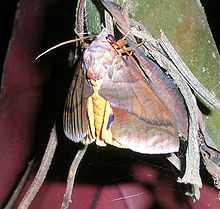Eudocima phalonia
| Eudocima phalonia | |
|---|---|
 | |
| Male (India) | |
| Scientific classification | |
| Kingdom: | Animalia |
| Phylum: | Arthropoda |
| Class: | Insecta |
| Order: | Lepidoptera |
| Family: | Noctuidae |
| Genus: | Eudocima |
| Species: | E. phalonia |
| Binomial name | |
| Eudocima phalonia (Linnaeus, 1763) | |
| Synonyms | |
| |
Eudocima phalonia is a fruit piercing moth of the Noctuidae family. It is found in large parts of the tropics, mainly in Asia, Africa and Australia but introduced into other areas such as Hawaii, New Zealand and the Society Islands.
The wingspan is about 90 mm.
The adult is considered an agricultural pest, causing damage to many fruit crops by piercing it with its strong proboscis in order to suck the juice. Attempts have been made to control them using baits for the adults,[1] egg parasites and larval parasitoids.[2]
The larvae feed mainly on vines belonging to the Menispermaceae but have also adapted to species of Erythrina[3] and are known to feed on Erythrina crista-galli, Erythrina fusca, Erythrina variegata, Carronia multisepala, Hypserpa decumbens, Legnephora moorei, Pleogyne australis, Sarcopetalum harveyanum, Stephania aculeata, Stephania forsteri, Stephania japonica and Tinospora smilacina.
Gallery
-

Male
-

Female
-

Female, dorsal view
-

Female, ventral view
-

Male, dorsal view
-

Male, ventral view
-

Larva
-

Pupa
References
- ↑ Reddy, G.V.P.; Cruz, Z.T.; Muniappan, R (2007). "Attraction of fruit-piercing moth Eudocima phalonia (Lepidoptera: Noctuidae) to different fruit baits". Crop Protection 26 (4): 664–667. doi:10.1016/j.cropro.2006.06.004.
- ↑ Sands, D.P.A.; Liebregts, W.J.M.M.; Broe, R.J. (1992). "Biological control of the fruit piercing moth, Othreis fullonia (Clerck) (Lepidoptera: Noctuidae) in the Pacific". Biological Control of Exotic Pests in the Pacific, XIX International Congress of Entomology, June 1992, Beijing.
- ↑ Reddy GVP; Cruz ZT; Bamba J & R Muniappan (2005). "Host adaptation of the fruit piercing moth, Eudocima fullonia". Physiological Entomology 30 (4): 398–401. doi:10.1111/j.1365-3032.2005.00465.x.